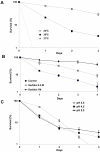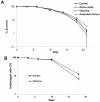Two-carbon metabolites, polyphenols and vitamins influence yeast chronological life span in winemaking conditions
- PMID: 22873488
- PMCID: PMC3503821
- DOI: 10.1186/1475-2859-11-104
Two-carbon metabolites, polyphenols and vitamins influence yeast chronological life span in winemaking conditions
Abstract
Background: Viability in a non dividing state is referred to as chronological life span (CLS). Most grape juice fermentation happens when Saccharomyces cerevisiae yeast cells have stopped dividing; therefore, CLS is an important factor toward winemaking success.
Results: We have studied both the physical and chemical determinants influencing yeast CLS. Low pH and heat shorten the maximum wine yeast life span, while hyperosmotic shock extends it. Ethanol plays an important negative role in aging under winemaking conditions, but additional metabolites produced by fermentative metabolism, such as acetaldehyde and acetate, have also a strong impact on longevity. Grape polyphenols quercetin and resveratrol have negative impacts on CLS under winemaking conditions, an unexpected behavior for these potential anti-oxidants. We observed that quercetin inhibits alcohol and aldehyde dehydrogenase activities, and that resveratrol performs a pro-oxidant role during grape juice fermentation. Vitamins nicotinic acid and nicotinamide are precursors of NAD+, and their addition reduces mean longevity during fermentation, suggesting a metabolic unbalance negative for CLS. Moreover, vitamin mix supplementation at the end of fermentation shortens CLS and enhances cell lysis, while amino acids increase life span.
Conclusions: Wine S. cerevisiae strains are able to sense changes in the environmental conditions and adapt their longevity to them. Yeast death is influenced by the conditions present at the end of wine fermentation, particularly by the concentration of two-carbon metabolites produced by the fermentative metabolism, such as ethanol, acetic acid and acetaldehyde, and also by the grape juice composition, particularly its vitamin content.
Figures






Similar articles
-
Genetic manipulation of longevity-related genes as a tool to regulate yeast life span and metabolite production during winemaking.Microb Cell Fact. 2013 Jan 2;12:1. doi: 10.1186/1475-2859-12-1. Microb Cell Fact. 2013. PMID: 23282100 Free PMC article.
-
Wine yeast sirtuins and Gcn5p control aging and metabolism in a natural growth medium.Mech Ageing Dev. 2012 May;133(5):348-58. doi: 10.1016/j.mad.2012.03.013. Epub 2012 Apr 2. Mech Ageing Dev. 2012. PMID: 22738658
-
Interplay among Gcn5, Sch9 and mitochondria during chronological aging of wine yeast is dependent on growth conditions.PLoS One. 2015 Feb 6;10(2):e0117267. doi: 10.1371/journal.pone.0117267. eCollection 2015. PLoS One. 2015. PMID: 25658705 Free PMC article.
-
Dominance of Saccharomyces cerevisiae in alcoholic fermentation processes: role of physiological fitness and microbial interactions.Appl Microbiol Biotechnol. 2016 Mar;100(5):2035-46. doi: 10.1007/s00253-015-7255-0. Epub 2016 Jan 5. Appl Microbiol Biotechnol. 2016. PMID: 26728020 Review.
-
The cellular symphony of redox cofactor management by yeasts in wine fermentation.Int J Food Microbiol. 2025 Jan 16;427:110966. doi: 10.1016/j.ijfoodmicro.2024.110966. Epub 2024 Nov 8. Int J Food Microbiol. 2025. PMID: 39536648 Review.
Cited by
-
Yeast thioredoxin reductase Trr1p controls TORC1-regulated processes.Sci Rep. 2018 Nov 7;8(1):16500. doi: 10.1038/s41598-018-34908-4. Sci Rep. 2018. PMID: 30405153 Free PMC article.
-
Resveratrol induces mitochondrial dysfunction and decreases chronological life span of Saccharomyces cerevisiae in a glucose-dependent manner.J Bioenerg Biomembr. 2017 Jun;49(3):241-251. doi: 10.1007/s10863-017-9709-9. Epub 2017 Apr 11. J Bioenerg Biomembr. 2017. PMID: 28401438
-
Genetic manipulation of longevity-related genes as a tool to regulate yeast life span and metabolite production during winemaking.Microb Cell Fact. 2013 Jan 2;12:1. doi: 10.1186/1475-2859-12-1. Microb Cell Fact. 2013. PMID: 23282100 Free PMC article.
-
A set of nutrient limitations trigger yeast cell death in a nitrogen-dependent manner during wine alcoholic fermentation.PLoS One. 2017 Sep 18;12(9):e0184838. doi: 10.1371/journal.pone.0184838. eCollection 2017. PLoS One. 2017. PMID: 28922393 Free PMC article.
-
Old yeasts, young beer-The industrial relevance of yeast chronological life span.Yeast. 2021 Jun;38(6):339-351. doi: 10.1002/yea.3650. Epub 2021 May 31. Yeast. 2021. PMID: 33978982 Free PMC article.
References
-
- Boulton RB. Principles and practices of winemaking. New York: Chapman & Hall; 1996.
-
- Ribéreau-Gayon P, Dubourdieu D, Donèche B. Handbook of enology. 2. Chichester, West Sussex, England ; Hoboken, NJ: John Wiley; 2006.
-
- Cebollero E, Rejas MT, Gonzalez R. Autophagy in wine making. Methods Enzymol. 2008;451:163–175. - PubMed
Publication types
MeSH terms
Substances
LinkOut - more resources
Full Text Sources
Molecular Biology Databases

